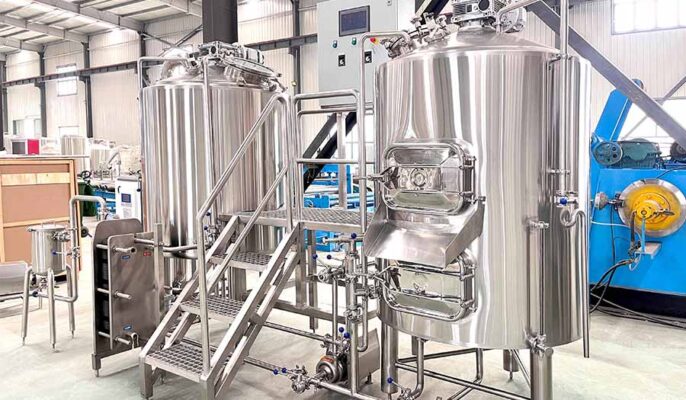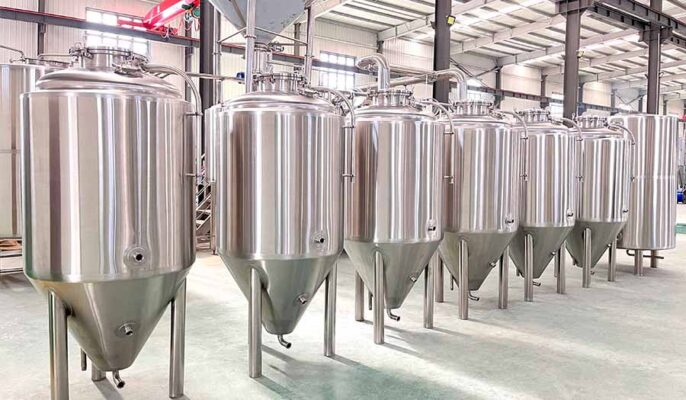A microbrewery system is a specialized brewing equipment setup designed to produce small batches of beer, typically ranging from a few gallons to hundreds of gallons. It is frequently used by craft breweries, home breweries, and small commercial breweries who value quality, creativity, and flexibility in their brewing process.
Microbrewery system definition
A microbrewery system is a specialized brewing equipment setup designed to produce small batches of beer, ranging from a few gallons to hundreds of gallons. It is used by craft breweries, home breweries, and small commercial breweries who value quality, creativity, and flexibility in their brewing process. Microbrewing systems can be manual or semi-automatic and are designed to accommodate a variety of beer styles and brewing techniques. Microbrewing systems vary in size and complexity, but they all focus on producing high-quality, unique beers in small batches.
Essential components of microbrewery equipment
High-performance microbrewing systems consist of several important components, each of which plays a key role in the brewing process. Here are some of the key components of a typical microbrewing system:
- Mash tun and kettle: The mash tun is where the brewing process begins, where grains and hot water are mashed to produce a sugary liquid called wort. The kettle is where the wort is boiled, hops and other ingredients are added, and flavors and aromas are developed.
- Fermentation vessel: After boiling, the wort is cooled and transferred to a fermentation vessel, where yeast is added to convert the sugar into alcohol and carbon dioxide. Fermentation vessels can be made of stainless steel, plastic, or glass and come in a variety of shapes and sizes.
- Cooling system: The cooling system is used to cool the boiled wort to prevent odor and ensure normal fermentation of yeast. This can be accomplished using a variety of methods, including heat exchangers or glycol cooling systems.
- Pumps and Hoses: Pumps and hoses are used to transfer wort and beer between different components of the brewing system, such as mash tuns, boilers, and fermentation vessels.
- Wort oxygenation system: Oxygen is necessary for yeast growth and fermentation. The wort oxygenation system is used to ensure that yeast has enough oxygen during the fermentation process.
- Control system: The control system is used to watch and regulate temperature, pressure, and other variables during the brewing process to ensure the consistency of beer quality and flavor.
These are a few of the important components of a high-performance microbrewing system. Specific components and configurations can vary depending on the brewer’s preference, budget, and brewing goals.

The development of microbrewing systems
The history of microbrewing systems can be traced back to the early 1980s when some pioneer brewers in the United States began experimenting with small brewing equipment to produce craft beers with unique flavors and styles. These early microbreweries faced significant challenges, including high startup costs, limited availability of quality ingredients and equipment, and a lack of consumer awareness and demand for craft beer.
Despite these obstacles, the microbrewing movement grew in the 1980s and 1990s, driven by the passion and dedication of a small but growing community of craft beer enthusiasts. As consumer tastes and preferences shift towards sourced, high-quality, artisanal products, microbreweries are starting to gain wider recognition and acceptance.
Microbrewery brewing process
Malt crushing system
Malt is crushed to better dissolve the substances in the malt. The malt is broken but not broken, and the husks act as a filter for wort filtration. The crushing system consists of a malt crusher, malt storage, and feeding equipment. Small equipment can only be equipped with malt crushers.
Brewhouse system
The mash system is the core of the entire brewing equipment and handles the process of turning malt into wort. There are four main process steps: “mash, filtration, boiling, and precipitation”. These four functional steps are completed by several tanks, which is called “several tank mashing”. A hot water boiler is an auxiliary equipment.
The main types of mash systems for small and medium-sized beer equipment are:
- Two sets of brewhouseequipment (mash filter tank + boiling vortex settling pot);
- Twoand three brewhouse tanks (brewhouse filter tank-vortex sedimentation tank+boiling pot);
- Two devices (brewhouse filter tank + boiling vortex sedimentation pot) + hot water pot;
- Three-equipment brewhouse(mash pot + filter tank + boiling vortex settling pot) + hot water pot;
- Four sets of equipment for mash (mash pot + filter tank + boiling pot + vortex settling tank) + hot water pot.
When choosing to buy beer equipment, determine the type, configuration, and scale of the saccharification equipment used based on site conditions, brewing process requirements, and output batch requirements. Also, consider investment costs.
Fermenter
The importance of a fermenter lies in its ability to control temperature and pressure during beer fermentation. This affects the final product, as temperature and pressure affect the flavor, aroma, and alcohol content of the beer. Fermenters also help prevent contamination and ensure consistent fermentation throughout the batch.
There are many types of fermenters, including open fermenters, closed fermenters, and conical fermenters. Open fermenters are less common because they are more susceptible to contamination, but some brewers prefer them because they can produce more complex flavors.
Regulating tank
Once the beer has completed the fermentation process, it can be transferred to a conditioning tank. This tank allows the beer to age and mature, which can affect the final flavor and quality of the beer. The conditioning process is crucial because it helps create a smoother, more refined beer with an better flavor.
There are many types of conditioning tanks, including horizontal tanks, vertical tanks, and bright tanks. Horizontal tanks are ideal for large breweries because they can hold large amounts of beer and are easy to clean. Vertical tanks are more used in small breweries because they take up less space and are easier to move. Bright tanks are used for carbonation and clarification and are airtight to prevent oxidation.

The difference between micro-brewing system and a traditional brewing system
- Batch size and production capacity: Microbrewing systems produce smaller batches of beer, ranging from a few gallons to hundreds of gallons, while traditional brewing systems are designed to produce larger quantities of beer, often over 1,000 gallons per batch.
- Level of automation: Micro-brewing systems can be manual or semi-automatic, giving brewers greater control over the brewing process and the ability to make adjustments on the , whereas traditional brewing systems are automated with little room for customization or change.
- Flexibility in recipe development: Micro-brewing systems provide greater flexibility in recipe development, allowing brewers to experiment with different ingredients, brewing techniques, and beer styles, whereas traditional brewing systems need greater flexibility in recipe development due to the need to remain consistent. Large batches tend to be more limited in quality and flavor.
- Beer Quality and Consistency: While both microbrewing and traditional brewing systems can produce high-quality beer, microbrewing systems allow for greater control over the brewing process, resulting in increased consistency and quality of the final product.
Micro brewing equipment heating method
Electric
We recommend electric heating for breweries up to 840L/7BBL as beyond this size you will start to consume a lot of electricity. It would be best to consider other options, but we would be happy to expand to a larger brewery and HLT based on your needs.
Direct fire
We recommend direct-fired heating for breweries above 600L/5BBL as this provides enough area for the combustion chamber below the vessel to work .
Steam
We recommend this option for breweries of all sizes if you can fit the cost into the budget and space for the equipment. You get optimal heating efficiency and the ability to use the steam in other areas of the brewery.
What type of microbrewing equipment do you want?
The higher the degree of automation, the easier it is to manufacture standardized products. It helps thicken the beer. Having the ability to brew a beer that can be replicated time and time again builds trust with your customers. Of course, automation costs more, and if your budget is tight, then look at where automation would be most beneficial to you and put in place it where possible. Of course, you can also contact micet, and our engineers will develop a microbrewery plan that is most suitable for you based on your situation.




